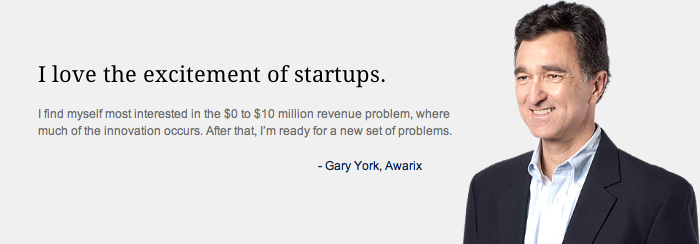Entrepreneur Stories

With three successful technology companies under his belt, Gary York’s track-record makes him one of the Southeast’s most respected technologists and serial entrepreneurs. His innovative solutions have enhanced routine outpatient healthcare, increased physician productivity and improved hospital profitability.
His path to entrepreneurial success began at Carnegie Mellon University, where he completed his PhD in Electrical and Computer Engineering in 1985. He spent the next five years as an electronic design automation engineer at venture-backed companies in Boston and Silicon Valley before relocating to Birmingham, Alabama.
With client-server web applications taking off in the mid ’90s, the market for Java development was heating up. Recognizing the opportunity, Gary founded his first company, Comframe, in 1997. What began as a small Java development firm quickly grew to become one of the Southeast’s premier software development shops. Eastside’s predecessor fund, Southeastern Technology Fund, was the lead investor in the company up through its sale to NWM Corporation.
In early 1998 UAB Medical School engaged Comframe to develop a solution to access electronic medical images from any PC in the hospital. At the time, less than 5% of hospitals had a picture archiving and communication system (PACS) system for storing, sending and retrieving electronic medical images. The few PACS systems in the market were bulky solutions with limited functionality.
It quickly became clear that Comframe’s product development for UAB had significant market potential. Gary founded his second company, Emageon, as a spin-off from Comframe. Southeastern Technology Fund again acted as Gary’s largest institutional investor, leading three rounds of financing in Emageon totaling more than $10 million.
Emageon’s innovations focused around PACS functionality. Up to that point, medical images weren’t viewed as an enterprise resource. Existing PACS vendors focused on single departments in the hospital, specific imaging modalities, and required the use of dedicated PACS workstations. Emageon redesigned the imaging workflow as its solutions allowed electronic medical images to be shared across every PC in the entire facility.
In the fall of 2004, the company was undergoing tremendous growth, had a market leading PACS solution, a significant customer backlog, and a steady stream of recurring revenue. The Board of Directors decided it was time to take the company public. In February 2005, the company raised more than $60 million via an IPO listing on Nasdaq.
Well before Emageon’s IPO, Gary’s wheels were turning on another venture. “I love the excitement of startups and the innovation required. I find myself most interested in the $0 to $10 million revenue problem. After that, I’m ready for a new set of problems,” says Gary.
In mid-2004, Gary began meeting with healthcare executives to shape his next idea. Among those executives was Curtis James, St. Vincent’s Hospital’s now-retired CEO. Gary and Curtis met repeatedly throughout the year to understand areas where St. Vincent’s would benefit from new technology and automation.
Curtis wanted to take real-time operating data and use it to immediately eliminate workflow inefficiencies. He didn’t want to wait until the end of the month to retrospectively analyze performance information. Instead, he wanted an optimization tool to reduce latency and thereby increase the hospital’s throughput.
In early 2005, Gary left Emageon and began working full-time on this next venture, which became Awarix. Curtis agreed to pilot Gary’s initial product at St. Vincent’s. Shortly thereafter, Gary called Eastside for assistance structuring his contract with St. Vincent’s. It was a delicate negotiation, as St. Vincent’s was a strategic partner, but also Awarix’s first potential paying customer.
“I called Eastside because I’d seen how they added value at Comframe and Emageon. I needed a partner who was process oriented and focused on sales execution. Additionally, I knew that they understood healthcare and had strong industry relationships,” says Gary.
In January 2006, Eastside made an early-stage investment in Awarix. The venture funding was used to build out the core product offering and scale the company’s sales force. “Eastside was extremely helpful building our sales organization. They identified and interviewed sales reps, advised on our pricing model, and established the metrics to measure success within our sales process,” says Gary.
Awarix’s products launched the enterprise patient visibility market, and within two years, over a dozen competitors were trying to replicate their innovative approach. Yet the fast-followers were not able to compete with Awarix’s product functionality and brand reputation in the rapidly growing space.
In the spring of 2007, Awarix received an unsolicited offer from McKesson to acquire the business. Since the company was undergoing tremendous growth, Eastside wanted to minimize the operational distractions of engaging in an exit process.
So, Emerson Fann provided Awarix with a $2 million term sheet to take into the negotiations with McKesson. “We wanted Gary and his team to quickly and aggressively pursue discussions with McKesson, and we wanted them to have the comfort of a capital cushion to fall back upon if negotiations fell apart,” says Eastside’s Emerson Fann. Negotiations proceeded smoothly, and in June 2007, Awarix sold to McKesson.
“Gary is a highly respected technologist and one of the most outstanding serial entrepreneurs that I know. He has the rare ability to both anticipate how markets will develop and position products to meet those developments. I’ve had the privilege to work with him through thick and thin and can say that he is a true investment partner. I look forward to what his future holds,” says Emerson.